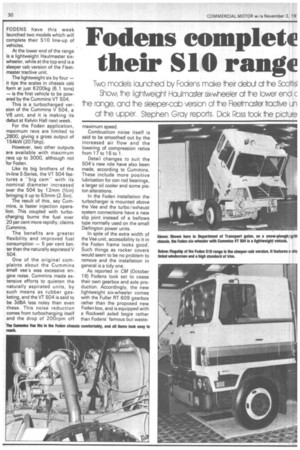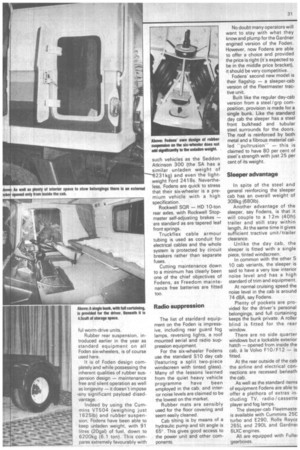Fodens complete their S10 range
Page 32

Page 33

If you've noticed an error in this article please click here to report it so we can fix it.
Two models launched by Fodens make their delar at the Scoltisl Show: -ne ligh-weight Haulmaster six-wleeler athe lower end c e range, and the sleeper-cab version of the Flee-master tractive un at the upper. Stephen Gray reports, Dick Ross took the picture
FODENS have this week launched two models which will complete their 510 line-up of vehicles.
At the lower end of the range
is a lightweight Haulmaster sixwheeler, while at the top end is a sleeper cab. version of the Fleet
master tractive unit.
The lightweight six by four — it tips the scales in chassis cab form at just 6200kg (6.1 tons) — is the first vehicle to be powered by the Cummins VT 504. This is a turbocharged version of the Cummins V 504, a V8 .unit, and it is making its debut at Kelvin Hall next week. For the Foden application, maximum revs are limited to .2800, giving a gross output of 154kW (207bhp).
However, two other outputs are available with maximum .revs up to 3000, although not 'for Foden.
Like its big brothers of the 'in-line E-Series, the VT 504 features a "big cam' with its nominal diameter increased over the 504 by 12mm (hin) bringing it up to 63mm (2.5in).
The result of this, say Cummins, is faster injection operation. This coupled with turbocharging burns the fuel over 20 per cent more rapidly, claims Cummins.
The benefits are greater flexibility and improved fuel consumption — 5 per cent better than the naturally aspirated V 504.
One of the original complaints about the Cummins small vee's was excessive en gine noise. Cummins made extensive efforts to quieten the naturally aspirated units, by
such means as rubber gasketing, and the VT 504 is said to
be 3dBA less noisy than even these. This noise reduction comes from turbocharging itself and the drop of 200rpm off maximum speed.
Combustion noise itself is said to be smoothed out by the increased air flow and the lowering of compression ratios from 17 to 16 to 1.
Detail changes to suit the 504's new role have also been made, according to Cummins. These include more positive lubrication for con rod bearings, a larger oil cooler and some piston alterations.
In the Foden installation the turbocharger is mounted above the Vee and the turbo/exhaust system connections have a new slip joint instead of a bellows type normally used on the small Darlington power units.
In spite of the extra width of the Vee unit, accessibility to it in the Foden frame looks good. Such things as rocker covers would seem to be no problem to remove and the installation in general is a tidy one.
As reported in CM (October 19) Fodens look set to cease their own gearbox and axle production. Accordingly, the new lightweight six-wheeler comes with the Fuller RT 609 gearbox rather than the proposed new Foden box, and is equipped with a Rockwell axled bogie rather than Fodens' famous but waste ful worm-drive units.
Rubber rear suspension, introduced earlier in the year as standard equipment on all Foden six-wheelers, is of course used here.
It is of Foden design completely and while possessing the inherent qualities of rubber suspension design — maintenance free and silent operation as well as longevity — it doesn't impose any significant payload disadvantage.
Indeed by using the Cummins V1504 (weighing just 16251b) and rubber suspension, Fodens have been able to keep unladen weight, with 91 litres (20gal) of fuel, down to 6200kg (6.1 ton). This compares extremely favourably with such vehicles as the Seddon Atkinson 300 (the SA has a
similar unladen weight of ---6231kg) and even the lightweight Ford 2418s. Nevertheless, Fodens are quick to stress that their six-wheeler is a premium vehicle with a high specification.
Rockwell SQR — HD 10-ton rear axles, with Rockwell Stopmaster self-adjusting brakes — are standard as are tapered leaf front springs.
Truckflex cable armour tubing is used as conduit for electrical cables and the whole system is protected by circuit breakers rather than separate fuses.
Cutting maintenance down to a minimum has clearly been one of the chief objectives of Fodens, as Freedom maintenance free batteries are fitted too.
Radio suppression
The list of standard equipment on the Foden is impressive, including rear guard fog lamps, reversing lights, a roof mounted aerial and radio suppression equipment.
For the six-wheeler Fodens use the standard S10 day cab (featuring a split two-piece windscreen with tinted glass). Many of the lessons learned from the quiet heavy vehicle programme have been n employed in the cab, and interior noise levels are claimed to be the lowest on the market.
Rubber mats are sensibly used for the floor covering and seem easily cleaned.
Cab tilting is by means of a hydraulic pump and tilt angle is 65'. This gives good access to the power unit and other components. No doubt many operators will want to stay with what they know and plump for the Gardner engined version of the Foden. However, now Fodens are able to offer a choice and provided the price is right (it's expected to be in the middle price bracket), it should be very competitive.
Fodens' second new model is their flagship — a sleeper-cab version of the Fleetmaster tractive unit.
Built like the regular day-cab version from a steel /grp composition, provision is made for a single bunk. Like the standard day cab the sleeper has a steel front bulkhead and tubular steel surrounds for the doors. The roof is reinforced by both metal and a fibrous material called "pultrusion" — this is claimed to have 80 per cent of steel's strength with just 25 per cent of its weight.
Sleeper advantage
In spite of the steel and general reinforcing the sleeper cab has an overall weight of 308kg (680Ib).
Another advantage of the sleeper, say Fodens, is that it will couple to a 12m (40ft) trailer and still stay within length. At the same time it gives sufficient tractive unit/trailer clearance.
Unlike the day cab, the sleeper is fitted with a single piece, tinted windscreen. In common with the other S 10 cab variants, the sleeper is said to have a very low interior noise level and has a high standard of trim and equipment.
At normal cruising speed the noise level in the cab is around 74 dBA, say Fodens.
Plenty of pockets are provided for the driver's personal belongings, and full curtaining keeps the bunk private. A roller blind is fitted for the rear window.
There are no side quarter windows but a lockable exterior hatch — opened from inside the cab, a la Volvo F10/ F12 — is fitted.
At the rear outside of the cab the airline and electrical connections are recessed beneath the cab.
As well as the standard items of equipment Fodens are able to offer a plethora of extras including TV, radio/cassette player and fog lamps.
The sleeper-cab Fleetmaste is available with Cummins 25C turbo • and E290, Rolls RoycE 265L and 290L and Gardnei 6LXC engines.
All are equipped with Fullei gearboxes.




























































































































